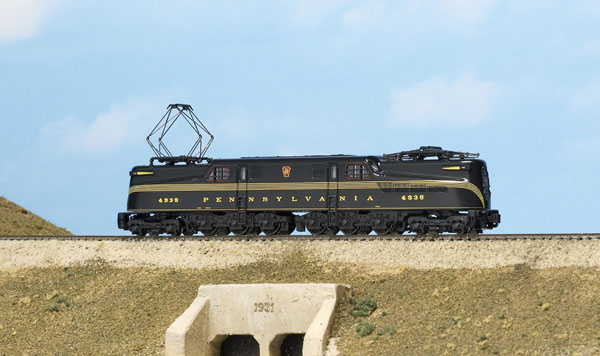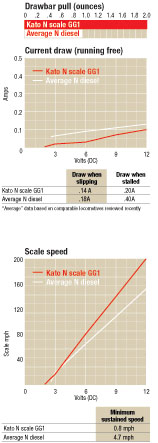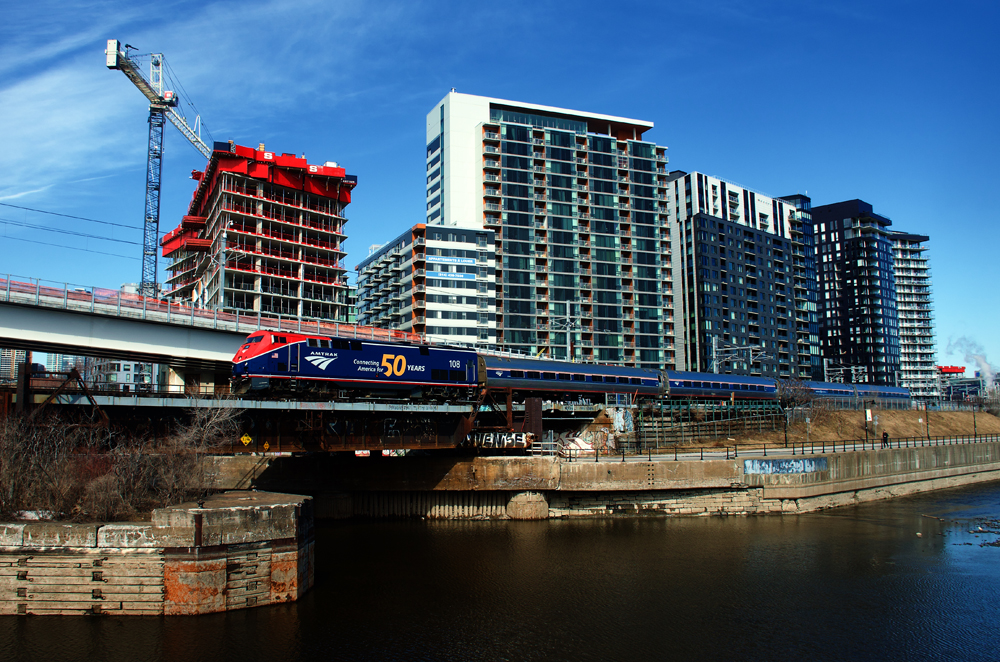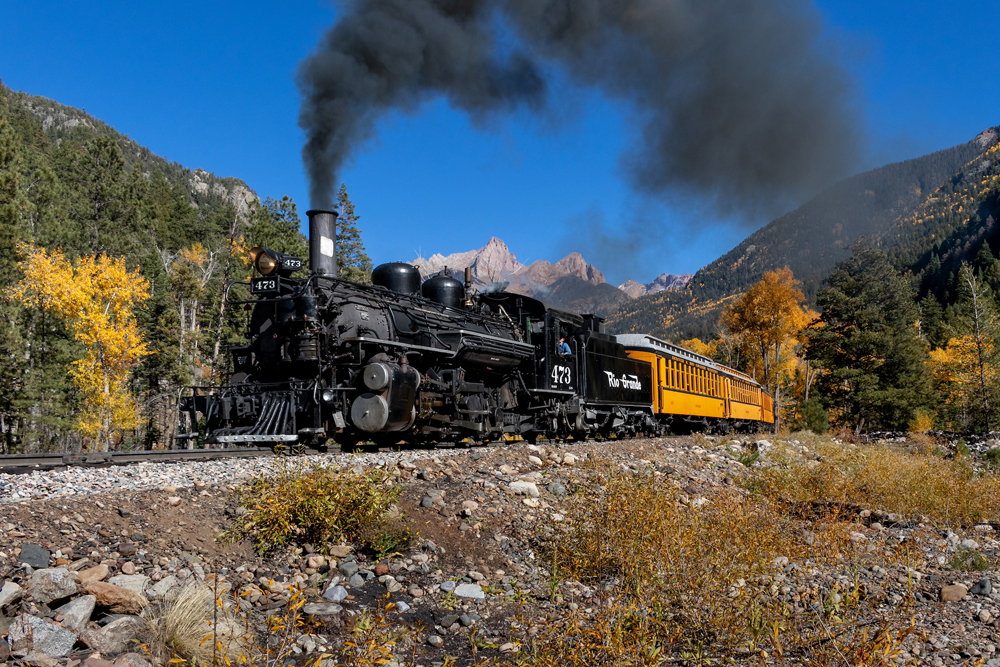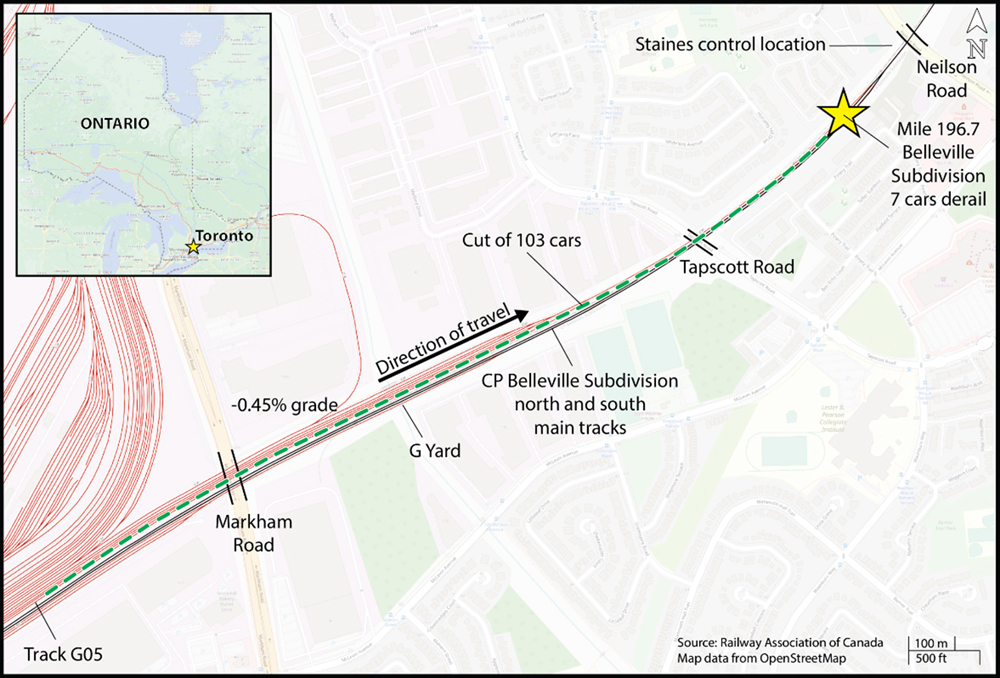The prototype. Baldwin Locomotive Works and General Electric built a prototype GG1 with a riveted body (no. 4899, later renumbered 4800) in 1934. Pleased with the success of “Old Rivets,” Pennsy ordered 14 more GG1 locomotives (4801 to 4814) from BLW and GE in 1935. After that initial order the Pennsy’s own Altoona Shops built the remainder of the GG1 fleet (4815 to 4938). Altoona built the last GG1 in 1943. All GG1 locomotives after “Old Rivets” no. 4899 had smoothly contoured welded carbodies.
The GG1 rode on an articulated 2-C+C-2 chassis (a two-axle idler truck on each end and three powered axles on each section of the chassis). With a pair of motors on each powered axle, the GG1 produced 4,620 continuous hp with peaks up to 8,500 hp. The top speed of a GG1 geared for passenger service was 100 mph. Starting in the 1950s the Pennsy regeared some GG1s to 90 mph for dual service (freight and passenger duties).
The last GG1 was retired in 1983. Several have been preserved, including no. 4935 at the Railroad Museum of Pennsylvania.
Details and paint. The dimensions of the Kato N scale model match those of drawings in the October 1994 issue of Model Railroader.
The Kato GG1 is decorated in the modified-Loewy paint scheme introduced in 1941. The model’s Brunswick green paint is the correct almost-black shade, and the serif Clarendon lettering font is appropriate for this era, as is the red pinstriping around the cab windows. The placement of the lettering, heralds, and striping matches prototype photos.
The lettering on the model is bright yellow in color. To match the prototype all lettering should be gold leaf. Later GG1 paint schemes used a dark yellow-gold shade called “Synthetic Buff.”
The model’s plastic body shell features sharply molded detail and captures the complex curves of the prototype. The side grills are especially well done. Separately applied details include cab ladders and window safety bars.
The non-functioning blackened metal pantographs raise and lower easily. When fully extended the pantographs are 25 N scale feet (17/8 inches) above the railhead.
All wheels are blackened metal, and the drive wheels measure a scale 57″ in diameter. The articulated frame and the idler truck sideframes have sharply molded details that match the prototype.
Our review sample had one traction-tire-equipped driver. The model’s drawbar pull was equivalent to 24 free-rolling N scale passenger cars on straight and level track. The GG1 should have plenty of power to pull the new 14-car Kato N scale Broadway Limited passenger train.
Converting the GG1 to DCC is easy. A printed-circuit board is mounted under a gray plastic cover atop the model’s split frame. Digitrax makes a drop-in DCC decoder (DN163K1D) that replaces the original PC board.
All lighting is from light-emitting diodes (LEDs) that have an orangish cast. The class lights would look more prototypical if they were white or green.
At 2 volts the model rolled steadily at only 0.8 scale mph. The GG1 accelerated to 200 scale mph at 12 volts, double the top speed of the prototype. A more prototypical 100 scale mph top speed is achieved at 8 volts.
The Kato GG1 ran smoothly through turnouts and around a 9¾” curve. However, the model looks much better on broader curves, especially when pulling passenger cars.
Despite its yellow lettering, the model looks great hauling the Kato Broadway Limited. The Kato GG1 is a good choice for N scalers who want to model the Pennsy’s electrified territory.
Price: $139.00
Manufacturer
Kato U.S.A. Inc.
100 Remington Rd.
Schaumburg, IL 60173
www.katousa.com
Description: Ready-to-run plastic and metal locomotive
Road name: Pennsylvania RR no. 4935 (Brunswick Green, five-stripe)
Blackened metal RP-25 wheels in gauge
Blackened metal pantographs
Can motor with dual brass flywheels
Compatible with Digitrax DN163K1D Digital Command Control (DCC) decoder (sold separately)
Drawbar pull: 2 ounces
Electrical pickup on 11 drivers
Kato operating knuckle couplers at correct height
Minimum radius: 93/4″
Sprung idler trucks
Weight: 5 ounces





